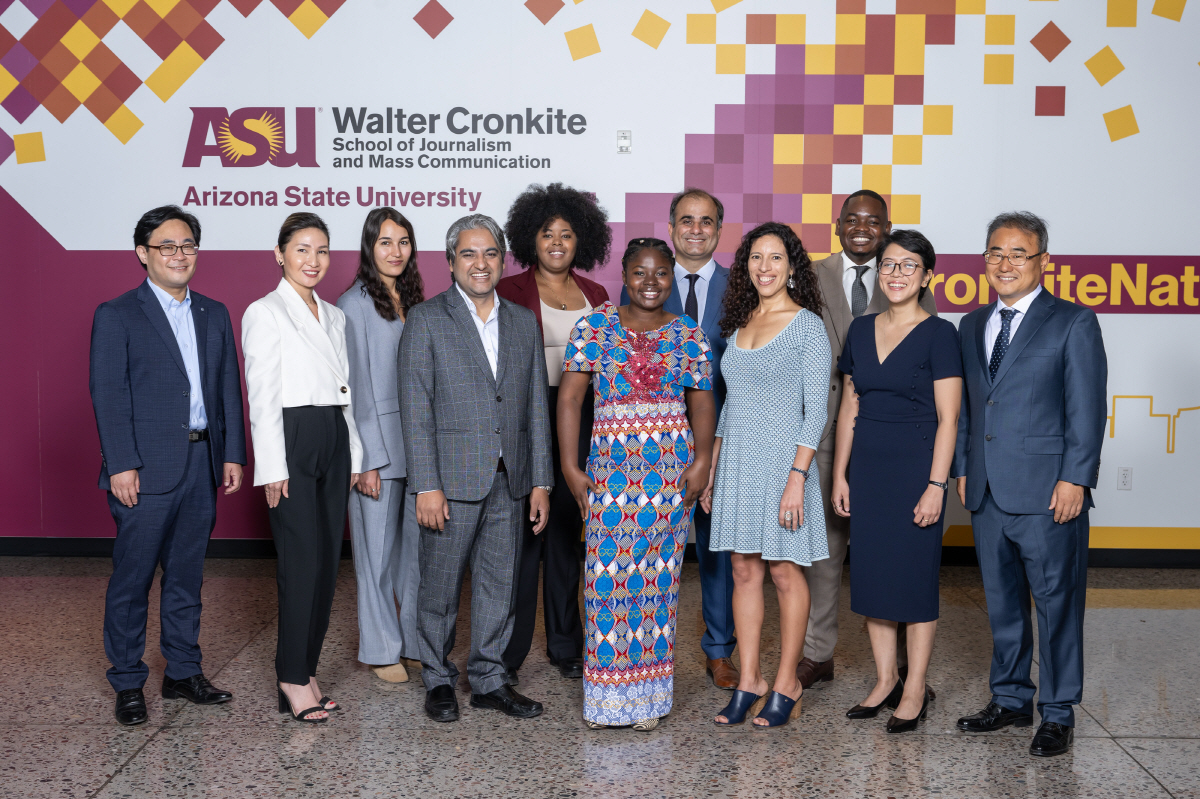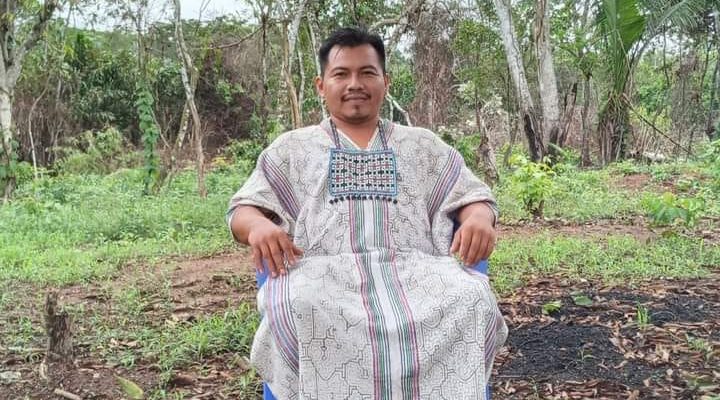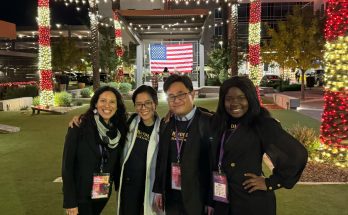<Lucio Muñoz is a shaman from the Shipibo-Konibo
community. He does ayahuasca
ceremonies in his Pino
Joni Ecologic Center, located in the city of Pucallpa,
Peru.>
The Amazon’s plant-based drink is gaining popularity despite being surrounded by secrecy. Although it is not a drug, there is still a lot of prejudice against it. However, regular people and celebrities, from Prince Harry to Aaron Rodgers, have tried it and been amazed by its healing power. Is ayahuasca the solution to our mental health and overall well-being?
Lucio Muñoz was 12 years old when he told his father he wanted to be like him. Antonio was a shaman from the Shipibo-Konibo community, an indigenous people of the Peruvian Amazon. The traditional healer gave his child a small dose of ayahuasca so he could connect with it and be protected. When Lucio turned 15, he officially became his father’s apprentice and, at 18, participated in his first ayahuasca ceremony under his dad’s guidance.
Out of Antonio’s ten children, three continued his legacy. Lucio, 33, also known as shaman Pexe Bima (“man surrounded by energy” in Shipibo language), is one of them. The next in line will be his two-year-old daughter Raipena, whose name means “medicinal woman.”
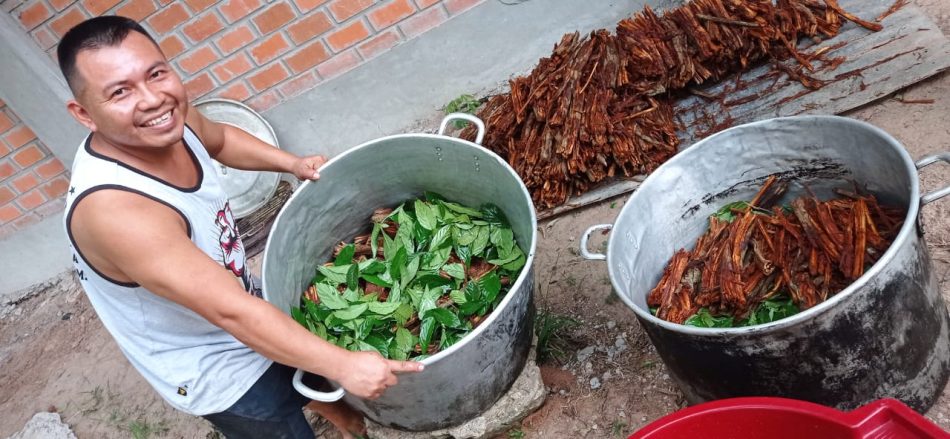
in the Amazon basin: the vine of ayahuasca and the chacruna shrub.>
Breaking down ayahuasca
Ayahuasca is a beverage that results from boiling two plants that grow in the Amazon basin: the vine of ayahuasca (Banisteriopsis caapi) and the chacruna (Psychotria viridis) shrub. If either plant is ingested on its own, nothing happens. However, brewing them together is a completely different story.
“The vine contains harmala alkaloids, whereas chacruna contains N, N-Dimethyltryptamine (DMT). If you have a decoction of the alkaloids and the DMT, the active hallucinogenic component, you get a potent synergistic effect because these alkaloids deactivate the enzyme system that would normally degrade the plant. So, it allows for the DMT to be absorbed through the gut. Then it activates the central nervous system facilitating a powerful several-hour visionary experience,” states Dr. Charles Grob, an American psychiatrist, professor at UCLA, and a researcher who did ayahuasca studies in Brazil in the ’90s and the early 2000s.
According to Dr. Grob, ayahuasca is becoming more well-known in the United States, and more people are interested in exploring it. But what about its legal status? Even though the DMT is in one of the plants, the drink itself is not considered a drug in the U.S.
“Ayahuasca is not a drug. It is an ancestral medicine that heals on a physical and psychological level. It is an emotional and spiritual awareness that integrates the person with themselves, not dissociates them. It is wisdom, human consciousness, and a sacred, visionary, super-powerful teacher that guides us. Ayahuasca is the purity of nature,” sums up Lucio.
In 2008, the National Institute of Culture of Peru declared “the knowledge and traditional uses of ayahuasca practice by the native Amazonian communities” as Cultural Heritage of Peru.

had four ayahuasca ceremonies with nine other people from all around the world.>
“Just let ayahuasca do its work”
Last year, after defending her dissertation at Arizona State University, Keti Tsotniashvili got sick. The 36-year-old Georgian education researcher went to the doctor but continued feeling ill. She needed a break and looked for a yoga retreat to relax and energize – but ended up going to an ayahuasca retreat in Iquitos, Peru, instead. “When doing my PhD, I was reading about alternative knowledge systems, indigenous ways of living, Peruvian healers, and their ways of seeing the world. I thought it was time to try ayahuasca because it was also a big life-changing moment for me. I was confused, thinking about what I wanted to do and where to go.” Keti spent 11 days in the Peruvian jungle and had four ayahuasca ceremonies with nine other people from all around the world. The shaman was a Shipibo called Miguel.
Tsotniashvili wanted to learn about her deep self. But first things first. She was weak, tired, and scared because her temperature was below 36. “It was a post-stress period for me. So, I just let ayahuasca do its work. The first night, I saw a small insect coming into every cell of my body, and I felt very evidently how I was getting healed physically. It was amazing!”
In the following ceremony, Keti felt something unsettling inside her body. She vomited and then had another vision: a closed wooden box inside her, which she couldn’t open. After vomiting again, she saw a snake moving inside her. “I experienced this movement in my brain, stomach, and intestines, and I understood that the snake was trying to help me get rid of this box. The animal came out of my mouth, but the box remained inside me. Suddenly, I knew what the snake thought: if it does not come out now, it should not. After that realization, the box sank. It was not heavy or disturbing anymore. Somehow, everything was out. I felt lightness.” The shaman told Keti the spirit animal of ayahuasca is the snake and that it was healing her emotionally.
“By the end, I was strongly connected with nature and myself: my body, emotions, senses, and mind. I had clarity and harmony and realized that is the goal,” she reflects.
Trauma, addictions, and the understanding of the universe
Lucio claimed that one ayahuasca ceremony could solve psychological issues that would take years to resolve in therapy. Mabel Loaiza, cognitive behavioral psychologist with 30 years of professional experience, agrees. “When it comes to resolving traumatic conflicts in individuals, modifying their consciousness can speed up the process. Although it may seem esoteric to many, ayahuasca is a method that alters consciousness and allows it to penetrate much deeper levels of a person’s consciousness. That is why, with proper guidance, it is effective for overcoming trauma and severe psychological difficulties.”
There is a saying: “Ayahuasca is for everybody, but not everybody is for ayahuasca.” People who have psychotic disorders, such as schizophrenia or bipolarity, cannot take it. Dr. Grob does not advise it to individuals who think this would be a recreational experience and affirms ayahuasca is very straightforward in treating addiction, like alcohol or drug abuse.
“I learned about the range of effects of ayahuasca through my own experience by observing others and talking with them. It is fascinating, and my experiences were very powerful. I got a great deal of insight into my own dynamics. It positively impacted my value system -the importance of honesty and compassion- gave me a greater appreciation of nature, and made me aware of its imperative value,” shares Dr. Grob.
Mabel has experienced ayahuasca too, with Lucio’s father, Antonio Muñoz, or shaman Senen Pani, which means “energy extended in space.” She has concluded that ayahuasca is ancestral knowledge that is highly beneficial as it sharpens our sensitivity, expands our perception, connects new areas of the mind, (reveals difficulties, brings out the unconscious), and releases sensations, emotions, and feelings that are often difficult to express through words. But she recommends it mainly because it allows us to comprehend the universe. As huge as that.
“Ayahuasca helps us to understand the universe. The indigenous people of the Amazon believe that everything in nature, from rocks to rivers, is alive, interconnected, and influencing each other. During one of my ceremonies, I transformed into a jaguar that ran through the forest. In another, I felt my human body contort like a vine on a plant. Even though I had never seen ayahuasca or chacruna before, I knew what they looked like and felt their power. We often think we are alone in this world, but we are not. Ayahuasca connects us with nature and the cosmos. This experience can profoundly change our competitive and destructive perspective, pushing us to work as a community like the Shipibos to make the world a better place, combat climate change, and prevent harm and suffering to other beings.”
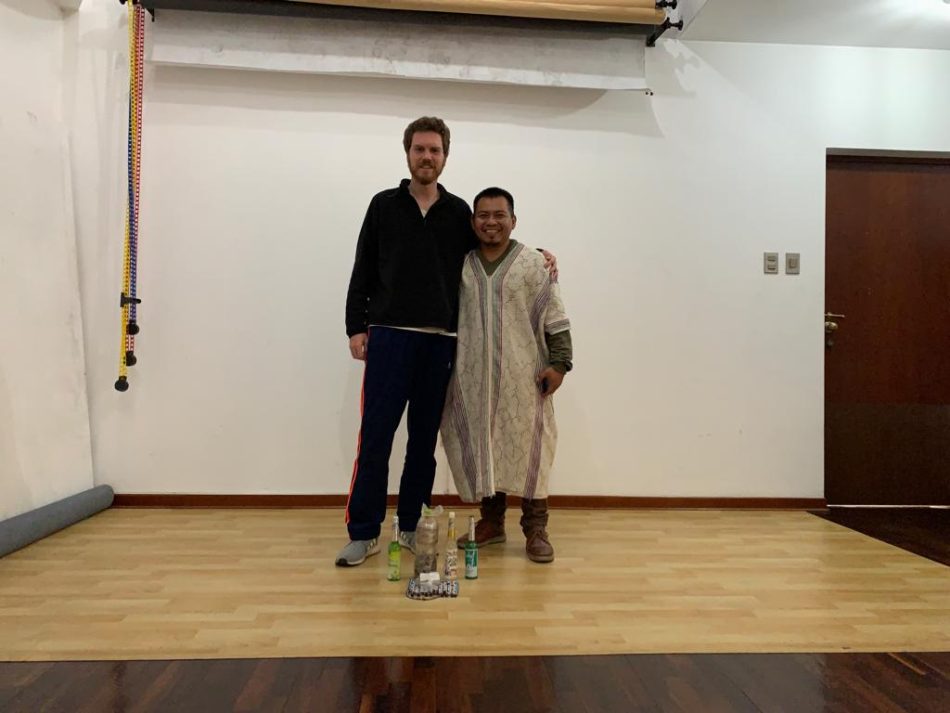
Spanish audiovisual communicator. In this photo, he poses with Lucio.>
“Ayahuasca does not stop helping you”
Like Keti Tsotniashvili, Carlos Rejano, 37, had four ayahuasca ceremonies. But unlike Keti, the Spanish audiovisual communicator did it in five years instead of 11 days. He learned about it for the first time as a college student. For him, ayahuasca was “an outsider drug, hard to access, and exotic.”
In 2014, Carlos moved from Madrid to Lima, where he heard again about ayahuasca. In 2019, he had the chance to try it with Lucio. In his first ceremony, Rejano saw and felt the presence of his father, who died in 2007. Ayahuasca brought him closer to his dad.
The third time was hard. “I was off, tired, saturated due to work and personal reasons. I had become a father for the first time, and those five months were stressful. At the ceremony, I connected with my son and my wife, who had a difficult birth, and I thought that ayahuasca had shown me the past. But two months later, I discovered it had shown me the future. During the session, I felt pain in my hip. That same pain appeared when the three of us got Covid. It was a long and terrible process because it was complicated by pneumonia. Ayahuasca prepared me to endure what came.”
In all the ceremonies, Carlos Rejano has received empowering messages. Fear disappears, and a feeling of peace and well-being remains. “There will be problems, noise, even depressive moments, but I have the certainty that everything, in the end, will be fine. Ayahuasca anchors you and lightens your emotional baggage. You connect with your higher self, the divinity, or whatever you want to call it, become aware of the challenges, and start changing things in your life. Ayahuasca does not stop helping you,” he affirms.
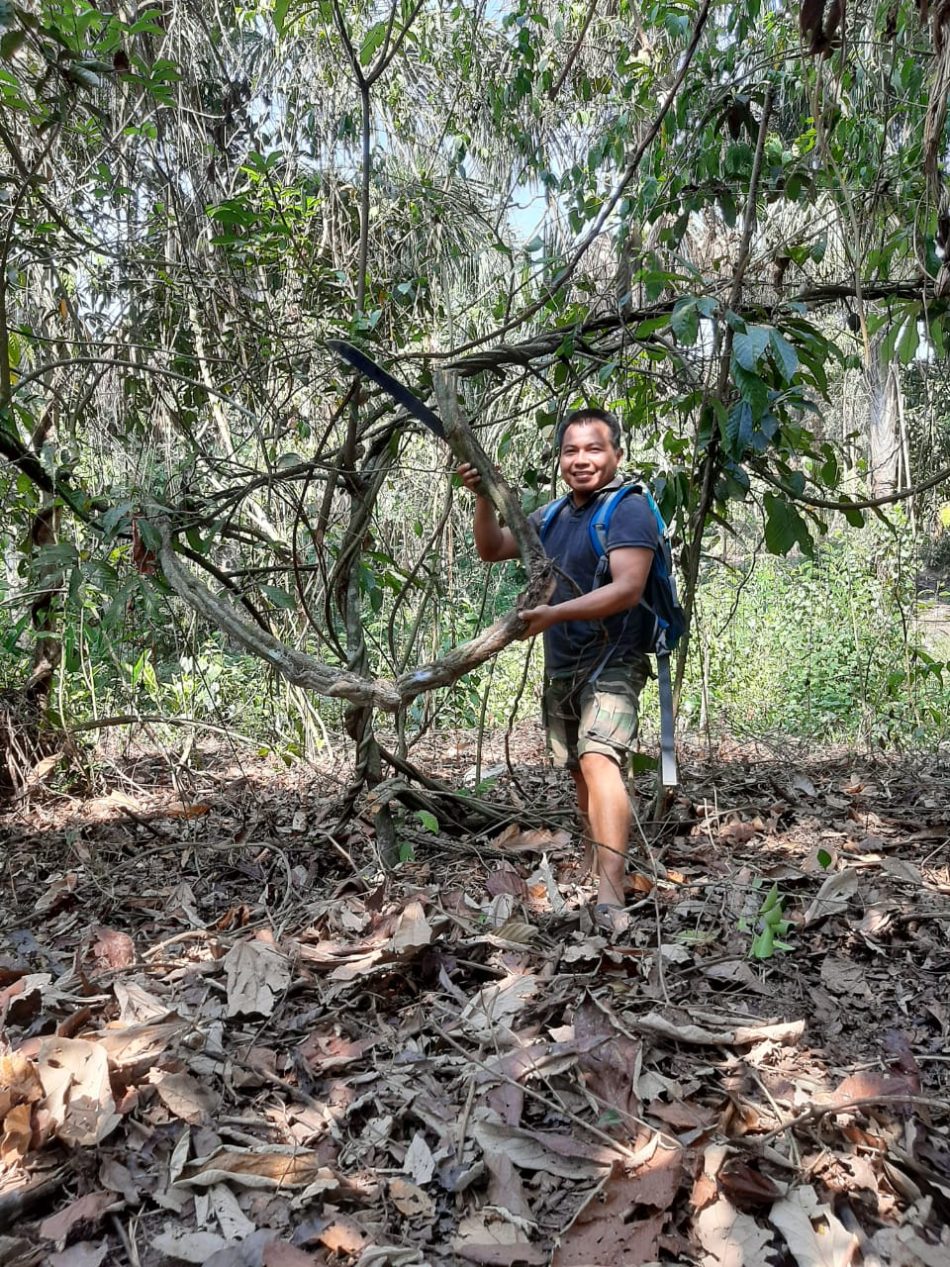
by energy” in Shipibo language), with the vine of ayahuasca.
Scarcity and cultural appropriation
Lucio does ayahuasca ceremonies in his Pino Joni Ecologic Center, located in the native community of San Francisco, city of Pucallpa, Peru. Although ayahuasca and chacruna grow in his backyard, nowadays, it is becoming increasingly difficult for him to find these plants due to their indiscriminate marketing for profit.
“Sometimes I have to buy them expensively. I began to think I should plant even 20 chacruna trees and 20 ayahuasca vines because there would be nothing in seven or 10 years. But to harvest it, you must wait at least six years – the ideal is 10. Another concern for me is the fake shamans. The shaman’s guidance is vital to ensure safe and responsible use of ayahuasca.”
According to Dr. Charles Grob, there is not only cultural appropriation but also biopiracy. “Ayahuasca is the heritage of the native peoples of the Amazon basin, and here we are, North Americans and Europeans coming over from an entirely different culture, taking advantage of the accrued knowledge over millennia of native peoples. We tend to feel better and more knowledgeable in the West than everybody else. But we need to understand that in this context, we are the students, and the teachers are the indigenous people who come from a lineage of ayahuasca use in South America. We have much to learn, and ayahuasca has much to offer as long as we respect and acknowledge its power.”
